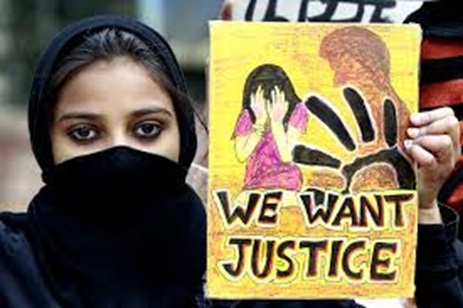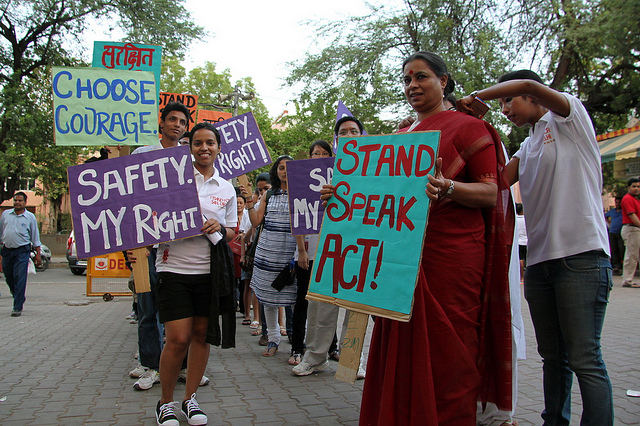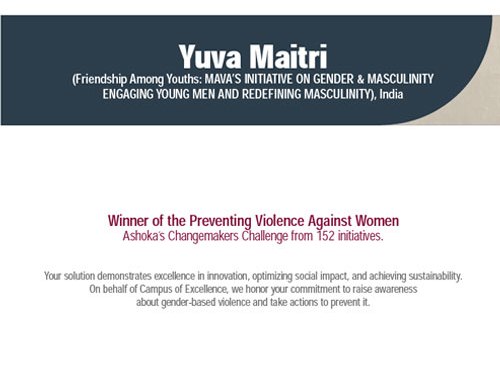Prime Minister Narendra Modi’s recent statement in Parliament – “stop analysing the psychology behind rape” and instead “protect the dignity of our mothers and our sisters” – was presumably aimed at political leaders who have been shooting their mouths off about the recent spate of sexual crimes that have again provoked shock and outrage across the country.
However, it also reflects the customary response to any suggestion that there are no quick-fix solutions to the knotty problem of sexual violence and any reference to the need to alter mindsets: typically impatient and dismissive. As a recent editorial in The Times of India, referring to the Prime Minister’s statement on the subject, put it: “We don’t need psycho- or socio-babble about rape, just nab rapists.”
Nevertheless, to return to the earlier analogy, there is an elephant in the chat room and we can continue to ignore it only at our peril. Two young journalists pointed to the beast in recent, revealing reports from the ground.
Neha Dixit had gone to cover an election rally in Shamli (UP) in early April when, as the only woman in a crowd of an estimated 40,000 men and boys, she was forced to beat a retreat – against her natural instincts and deeply held principles – by the threatening barrage of shouts, taunts, insults, sexually explicit propositions, clicking of cellphone photos, et al, unleashed on her.
The fact that she was “modestly” dressed in a salwar- kameez and dupatta obviously made no difference: being female in a “male” space was evidently provocation enough. A concerned, elderly, local man advised her to cover her face with her dupatta and leave because “these boys are like this only.”
Nishita Jha’s conversations with young men in Badaun who tried to convince her that the girls found hanging from a tree were victims of “honour killing” rather than rape and murder – with grisly references to the more prudent, available option of cutting the girls up and throwing their body parts in the river, etc. – threw up the word dabangg: “a word one encounters constantly in Uttar Pradesh – on shop windows, hoardings, film-reviews over chai. It refers to a certain swagger, an over-the-top masculinity that eclipses even the mustachioed Salman Khan.”
The arguments put forward by Jha’s “tea-time companions” echo the infamous statements of several politicians – variations on the theme outlined by Mulayam Singh Yadav in April: “Boys will be boys… they commit mistakes,” “First girls develop friendship with boys. Then, when differences occur, they level rape charges.”
Denial as defence
Unfortunately, such views are not confined to the outbacks of UP or to politicos. An April 2012 sting operation by Tehelka magazine revealed that the overwhelming majority of senior policemen across 23 police stations in the National Capital Region had appalling and alarming opinions on who and what was responsible for rape.
A senior lawyer serving as a resource person at a training workshop for legal aid lawyers found that the predominantly male participants held almost identical views.
A judge hearing a rape case in a Fast Track Court in Delhi in October 2013 made similar sweeping statements about “false cases,” besides delivering a homily on pre-marital sex, warning that girls who “indulge” in it should not “cry later on that it was rape.” Needless to say, no one ever seems to think of advising boys or men about sexual conduct.

Pic: www.csrindia.org
The websites of a number of urban organisations that are supposedly part of a men’s rights movement also reveal that the young men in Badaun are not alone in believing that the official data on crimes against women is inflated by what they claim is the “blatant misuse of Sections 376 and 498a, the rape and dowry laws of the Indian Penal Code.”
From the content on various sites and blogs, it appears that these organisations (most with names revolving around the “Indian Family”) focus more on the alleged victimisation of men by women – through allegedly false charges of dowry harassment, sexual harassment, domestic violence and rape and, reportedly, through violence against husbands by wives – than on genuinely seeking freedom for men from rigid, limiting, stressful gender-based roles and stereotypes.
According to Atit Rajpara, a 35-year-old software engineer and co-founder of Men’s Rights Association (MRA), the low conviction rate in rape cases (less than a quarter of those that reach the courts) is “because most of them are false cases.” Amit Deshpande, president of Protect Indian Family and founder of Vaastav, an umbrella body of men’s rights organisations, believes that “most rape cases are sexual liaisons gone awry.”
While there may well be some cases involving consensual sexual relationships gone sour, given the risk of social stigma – to which women admitting to pre- or extra-marital affairs continue to be far more vulnerable than men – it seems unlikely that such instances constitute the trend implied by the Supreme Court’s recent observations on the subject.
The overall perspective of most of these organisations is reflected in the headline of a recent press interview with Deshpande: “Men are persecuted at every level.” The resulting victimology seems to legitimise the misogyny that permeates them. It is sobering to remember that Elliot Rodger, the young man who recently killed several people and wounded many others in California, was involved with the online men's rights movement in the US, which admittedly has different preoccupations but is also characterised by misogyny.
Hostility, if not hatred, towards women abounds elsewhere on the Internet as well. While persons of all sexes have to deal with the nuisance of trolls (who appear particularly active around issues of gender and/or religious identities), women are routinely and specifically targeted with gendered hate mail, sexualised slurs, gratuitous references to bodies, nudity and sex, as well as threats of sexual violence – often explicit and graphic.
Writer Meena Kandasamy was famously called predictable names and threatened with various forms of violence, including acid attack and gang-rape, with at least one man proposing that the rape be televised. Singer Chinmayi Sripada was also called offensive names and threatened with rape and murder. Members of the Kashmiri female rock band, Pragaash, were subjected to vile abuse.
And these are just a few examples that received some public attention; many women at the receiving end of such virtual violence quietly deactivate their accounts or resort to self-censorship to avoid further attack – very few have the stomach to endure, ignore or fight it.
Female journalists and bloggers are often stalked, insulted and threatened online in the course of their work. Senior television journalist Sagarika Ghose has been quoted as saying that such online abuse is “the social media version of gang-rape."
According to a study by the Internet Democracy Project, responses to women’s opinions on the Net often go beyond what can be accepted as legitimate criticism and are commonly a mix of sexist and sexually explicit comments and suggestions. Noting the striking similarity between the Internet and the street (or any public space) in this respect, the researchers suggest that sexist abuse is to the Internet what sexual harassment is to the street.
Continuum of violence
Street sexual harassment and rape are dissimilar only in that they are located at different points along the continuum of violence against women in general and sexual violence in particular. Online abuse is clearly a new addition to the spectrum. The links between different forms and levels of gender-based violence – and the attitudes that underlie them and are revealed by them – are critical to attempts to understand rape and figure out how to tackle the problem.

A demonstration march, demanding safety for women in public spaces in the city. Pic: Centre for Social Research, India (www.csrindia.org)
Almost every high-profile case of sexual violence, especially rape, leads to such efforts. It is only natural that most analyses, especially in the media, take into account the specifics of the particular crime or crimes in the news at the time.
In the aftermath of the December 2012 gang-rape in Delhi, for example, there have been a few, welcome efforts to grapple with the relationship between men and prevailing notions of masculinity, on the one hand, and violence against women, including but not only sexual violence, on the other.
The focus last year was, understandably, on disadvantaged, dispossessed, disempowered, disaffected young men in urban areas; after the tragedy in Badaun, it has widened to include ill-educated, unemployed, prospectless young men in rural areas – both sets of men perceived as part of a “lost generation” catapulted out of an old, familiar world but denied entry into a tantalising but alien new one.
The trouble is that while that particular profile may, to some extent, be applicable in several cases of gang-rape that have hit the headlines in recent times, it doesn’t quite fit the picture of other, pervasive forms of violence against women, including sexual violence – online or offline. It is clearly impossible to pinpoint what triggers such violence. If some identifiable factors apply in some cases, they are not relevant in others, which may instead be explained by a different set of possible elements.
While some rapists are strangers, others are family members, friends, colleagues or acquaintances. While some rapists clearly take advantage of the power – spiritual or temporal – that they wield over fellow human beings (especially women and children), others appear to desperately seek a sense of power, however fake and fleeting, through the act of rape.
Constant reality
However, one inescapable verity is that the overwhelming majority of those who commit sexual crimes is male, irrespective of whether their prey is female or male.
It goes without saying that not all men are rapists – nor, indeed, are all men prone to any type of violence: gender-based, sexual or otherwise. Many men are as horrified and sickened by such behaviour as most women are. Not all men are misogynists either. We know this. Some of our best friends, relatives and colleagues are men.
It is clear, therefore, that “nature” is not the culprit. So it must be “nurture” – the social and cultural lessons that boys and girls, men and women absorb from the patriarchal society we live in about what it is to be male and female, manly and womanly, masculine and feminine.
Many girls and women – even in “Bharat” – have been exposed to ideas about women’s rights and gender equality that have been in the air over the past few decades and have enabled them to question, even reject, at least some of these gender-based prescriptions.
In the absence of parallel efforts to encourage boys and men to see that they, too, could benefit from less rigid, less demanding gender roles and expectations, as well as more equal relationships, it is only to be expected that many would view changing gender equations as an affront, a challenge to their manhood. The hyper-masculinity promoted through various forms of popular entertainment can only make things worse.
The resulting confusion, frustration and resentment – in combination with various social, cultural, economic and even political factors, as well as the high levels of both general and gender violence that have come to be the norm in society today – cannot but create an explosive mix.
Girls and women (and persons belonging to sexual minorities) are relatively easy targets for boys and men seeking to reassert male supremacy even if – possibly because – they cannot do much about the other circumstances that make them feel vulnerable and victimised.
Clearly not all men who feel this way commit rape. Some brutalise their wives or other female family members. Others injure and permanently disfigure women they are angry with by throwing acid on them. Some stalk women to intimidate them. Others opt for sexual harassment on the street or at the workplace. Many, increasingly, take recourse to online abuse and threats.
A large number may not act out their conflicted feelings about gender relations but give vent to them via the pervasive “rape culture” which normalises and often excuses sexual violence against women through sexist and misogynistic language, sexist and sexually explicit jokes, the objectification of women’s bodies, the trivialisation of sexual assault and tolerance of sexual harassment, the tendency to blame the victim and seek explanations for sexual violence in women’s appearance, character or conduct, and so on.
The infamous pronouncements of various politicians, policemen, lawyers and judges about sexual violence arise from and reinforce this rape culture. Popular entertainment contributes to it, too, and Yo Yo Honey Singh is just a particularly pernicious example. The fact that compilations of “HOT” rape scenes from Bollywood (and no doubt Kollywood, Mollywood, Tollywood, et al) movies are readily available on the Net tells a sordid tale.
Women are not immune to the rape culture surrounding them – how can they be, when it is “nurture,” more than “nature,” that shapes attitudes and behaviour?
Like the women among the relatives and former neighbours of the men accused of the Badaun atrocity interviewed by Priyanka Dubey, many other women, too, tend to blame the victim. Female politicians like Mamata Banerjee and Kakoli Ghosh Dastidar in West Bengal, and a member of the Maharashtra State Women's Commission, Asha Mirje, are among those who have made deplorable remarks on rape in the recent past.
Psycho babble?
All this is not psycho- or socio- babble. The widely acclaimed January 2013 Report of the Committee on Amendments to Criminal Law, headed by Justice JS Verma, devoted an entire chapter to “Education and Perception Reform,” highlighting the need to counter the effects of patriarchy, gender-based socialisation and the attendant hierarchies, prejudices, stereotypes and expectations, as well as gendered notions of power and entitlement, which together create the conditions in which rape and rape culture thrive.
The chapter refers to “a cult of masculinity, a cult of aggression” and calls for a critical “rethinking on basic assumptions of male, female and other identities” as an essential part of efforts to deal with the scourge of sexual violence.
Members of the committee, who heard and read over 80,000 submissions from across the country and beyond, were obviously convinced that better laws, policing, prosecution and punishment are necessary but not sufficient tools to deal with such a deep-rooted problem.
In the context of union health minister Harsh Vardhan’s recent, controversial remarks about sex education, it is significant that the Justice Verma committee strongly endorsed sex and sexuality education that also tackles issues of gender – in schools and elsewhere – as a vital aspect of such efforts.
The reportedly growing number of minors committing serious crimes like rape makes this a more urgent need than ever before. According to the National Crime Records Bureau’s 2012 report on Crime in India, 1316 juveniles had been booked for rape charges and another 685 for molestation that year. The just-released 2013 report records 1884 juveniles charged with rape and 1424 charged with “assault on women with intent to outrage her modesty” (another 312 are charged with “insult to the modesty of women”).
A recent report titled "The Making of Sexual Violence: How Does a Boy Grow Up to Commit Rape?" – based on research done in five countries, including India, under the IMAGES project – provides some clues about the nature of the monster in our midst: toxic notions of manhood and masculinity in which gender inequality and misogyny are embedded.
Nearly a quarter of the men interviewed across seven states in India reported having perpetrated sexual violence at some point, the vast majority against an intimate partner (wife or girlfriend). While the study did not specifically test the relationship between attitudes and sexual violence, researchers found that “men who held more rigidly masculine attitudes were three times more likely to perpetrate physical intimate partner violence than men who held more equitable gender attitudes.”
According to the report, “Sexual violence emerges from a mindset that grants men a sense of sexual entitlement and devalues women’s bodies and agency in sexual decision-making.” Although a wide range of institutional, cultural, and other factors combine to underpin violence in society, the findings of the IMAGES survey, as well as other evidence, suggest that attitudes drive sexual violence much more than individual pathologies or demographic indicators.
So, clearly, issues of power, privilege, entitlement, gender norms and sexism have to be addressed – especially with men and boys – if the problem of sexual violence is to be effectively tackled. As Brian Heilman, the report’s co-author, puts it, “If we leave men out, we’re essentially burdening women and girls with the task of ending this global epidemic of violence alone. Doing so also under-utilises the powerful influence that men who reject violence can have on their friends and peers.”
The recent massacre in California and the ensuing #NotAllMen - #YesAllWomen debate prompted a number of thoughtful and helpful reflections by men in the US on the connections between masculinity, misogyny and violence. The good news is that some men here, too, are exploring these links and working in diverse, constructive ways to create alternative visions of being male and human.
Recognition for "Men Against Violence against Women" (MAVA) from Ashoka. Pic: www.mavaindia.org
Perhaps organisations such as Men Against Violence Against Women (MAVA), projects such as Yuva Maitri and Let’s Talk Men, and individuals like blogger Indian Male Feminist can lead the way towards a more affirmative men’s movement and a less violent world for all.
It is absolutely important to nab rapists and bring them to justice. But it is just as important to try and put a stop to rape. And, in the end, rape prevention is not simply about women teaching women (or everyone preaching to women) how not to get raped – it is equally about men teaching men not to rape.

























